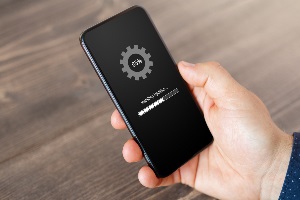Money Smarts Blog
10 Modern Tips to Securely Configure Your New Tech Devices
Dec 14, 2023 || Dennis Busch, Information Security Director

Did Santa surprise you with the latest smartphone or a top-tier gaming PC this year? That's fantastic! But before you explore the vast capabilities of your new gadgets, prioritizing their safety and security is crucial. In today's digital age, where every device is a potential entry point for cyber threats, securing them is more vital than ever.
Here's a sleigh-full of tips to securely configure and enjoy your new tech treasures:
- Update default settings and passwords: Default passwords are a hacker's delight. Change these immediately with strong, unique passwords or passphrases. Consider using a reliable password manager to keep track of your credentials.
- Strengthen your Wi-Fi security: Protect your network with the latest encryption standards. Wi-Fi Protected Access 3 (WPA3) offers robust security. Ensure your router is updated and configured to use WPA3.
- Enable multi-factor authentication (MFA): Add an extra layer of security by using MFA. This can include biometrics, a trusted mobile device, or an authenticator app. MFA significantly reduces the risk of unauthorized access.
- Limit location services and remote connectivity: Be cautious with location tracking and Bluetooth connectivity. Disable these features when not needed to protect your privacy and reduce vulnerabilities.
- Be mindful of eavesdropping risks: Devices like digital assistants and smart toys can inadvertently record private conversations. Disconnect them when not in use and cover device cameras for added privacy.
- Conceal your Wi-Fi network name (SSID): Avoid broadcasting your SSID. This makes it harder for outsiders to detect and target your network. Rename your SSID to something non-identifiable.
- Install a network firewall: Use a firewall to guard against external attacks. Check that your router's built-in firewall is activated and properly configured. A good firewall monitors incoming and outgoing traffic, blocking suspicious activity.
- Firewalls on individual devices: Besides a network firewall, install personal firewalls on all connected computers. Modern operating systems offer built-in, customizable firewalls that provide an additional security layer.
- Minimize risks by removing unnecessary software: Disable any services and software that aren't in use. This reduces potential entry points for attackers. Always have a reputable antivirus program installed and keep it updated.
- Regularly update and patch your devices: Stay vigilant with updates. Automate them where possible, and always source updates directly from manufacturers to avoid malware.
Remember: Security is an ongoing process. Stay informed about the latest security trends and practices to protect your digital life.
Additional Resources:
National Cybersecurity Alliance
Cybersecurity and Infrastructure Security Agency (CISA)
10 Modern Tips to Securely Configure Your New Tech Devices
Dec 14, 2023 || Dennis Busch, Information Security Director

Did Santa surprise you with the latest smartphone or a top-tier gaming PC this year? That's fantastic! But before you explore the vast capabilities of your new gadgets, prioritizing their safety and security is crucial. In today's digital age, where every device is a potential entry point for cyber threats, securing them is more vital than ever.
Here's a sleigh-full of tips to securely configure and enjoy your new tech treasures:
- Update default settings and passwords: Default passwords are a hacker's delight. Change these immediately with strong, unique passwords or passphrases. Consider using a reliable password manager to keep track of your credentials.
- Strengthen your Wi-Fi security: Protect your network with the latest encryption standards. Wi-Fi Protected Access 3 (WPA3) offers robust security. Ensure your router is updated and configured to use WPA3.
- Enable multi-factor authentication (MFA): Add an extra layer of security by using MFA. This can include biometrics, a trusted mobile device, or an authenticator app. MFA significantly reduces the risk of unauthorized access.
- Limit location services and remote connectivity: Be cautious with location tracking and Bluetooth connectivity. Disable these features when not needed to protect your privacy and reduce vulnerabilities.
- Be mindful of eavesdropping risks: Devices like digital assistants and smart toys can inadvertently record private conversations. Disconnect them when not in use and cover device cameras for added privacy.
- Conceal your Wi-Fi network name (SSID): Avoid broadcasting your SSID. This makes it harder for outsiders to detect and target your network. Rename your SSID to something non-identifiable.
- Install a network firewall: Use a firewall to guard against external attacks. Check that your router's built-in firewall is activated and properly configured. A good firewall monitors incoming and outgoing traffic, blocking suspicious activity.
- Firewalls on individual devices: Besides a network firewall, install personal firewalls on all connected computers. Modern operating systems offer built-in, customizable firewalls that provide an additional security layer.
- Minimize risks by removing unnecessary software: Disable any services and software that aren't in use. This reduces potential entry points for attackers. Always have a reputable antivirus program installed and keep it updated.
- Regularly update and patch your devices: Stay vigilant with updates. Automate them where possible, and always source updates directly from manufacturers to avoid malware.
Remember: Security is an ongoing process. Stay informed about the latest security trends and practices to protect your digital life.
Additional Resources:
National Cybersecurity Alliance
Cybersecurity and Infrastructure Security Agency (CISA)